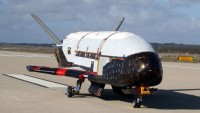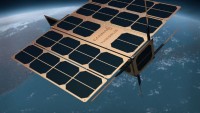China is Testing an EmDrive on Tiangong-2? Really?
| Arthur Dominic Villasanta | | Nov 08, 2016 06:11 PM EST |
(Photo : CAS) Tiangong-2 as seen from its companion satellite, Banxing-2.
Unbelievable as it may sound, there are media reports claiming China is testing its own version of an EmDrive thruster on its new Tiangong-2 space station in low earth orbit.
Like Us on Facebook
Unbelievable because China's few laboratory tests of the EmDrive all failed to replicate the results achieved by the EmDrive's inventor Robert Shawyer in 2006. An EmDrive engine also wasn't on the publicly declared manifest of items taken aboard Tiangong-2 by two Chinese "taikonauts" ferried to the space laboratory by Shenzhou 11 last Oct. 17.
But since China's "civilian" space program is a space weapons development program run, managed and funded by the People's Liberation Army (PLA), an EmDrive could have been smuggled onto Tiangong-2 by the taikonauts.
While news China might indeed be testing an EmDrive thruster in secret aboard Tiangong-2 seems implausible, it is nevertheless lent some credence by China's persistent attempts over a decade to build an EmDrive that actually works.
The driving force behind China's passion for the EmDrive is Prof. Yang Juan of the Northwestern Polytechnical University (NWPU) in Xi'an province.
Prof. Yang and his NWPU team were one of the first in the world to try to build their own version of the EmDrive. In 2008, Prof. Yang and his team allegedly verified the theory behind RF resonant cavity thrusters.
From 2010 to 2014, Prof. Yang's team published a series of theoretical and experimental papers reporting they had measured net thrust.
They then built their own EmDrive thruster in 2010, testing the drive multiple times from 2012 to 2014. Tests results published by the Chinese Academy of Sciences were said to be positive, achieving up to 750 mN (millinewtons) of thrust, and requiring 2,500 watts of power, comparable to conventional ion thrusters.
In 2014, however, they found the thrust measured was a false positive experimental error due to a power cable.
When they revised the study with an improved EmDrive prototype, they found any possible thrust being emitted by the device was far too small for their laboratory experiment to measure.
Invented by British scientist Robert Shawyer, an EmDrive is a propelantless propulsion system where a rocket engine doesn't burn any chemical propellant to cause a reaction that pushes a rocket forward. Theoretically, an EmDrive can reach extremely high speeds that will allow astronauts to journey to Neptune in only a few months.
The EmDrive is a "reactionless" drive in conflict with the law of conservation of momentum, which states that within a closed system, linear and angular momentum remain constant regardless of any changes that take place within said system. In other words, unless an outside force is applied, an object will not move.
The EmDrive is what is called an "RF resonant cavity thruster." It works by having a magnetron push microwaves into a closed truncated cone, then push against the short end of the cone to propel a spacecraft forward.
TagsEmDrive, Tiangong-2, Shenzhou 11, Prof. Yang Juan, Northwestern Polytechnical University, Robert Shawyer
©2015 Chinatopix All rights reserved. Do not reproduce without permission
EDITOR'S PICKS
-

Did the Trump administration just announce plans for a trade war with ‘hostile’ China and Russia?
-

US Senate passes Taiwan travel bill slammed by China
-

As Yan Sihong’s family grieves, here are other Chinese students who went missing abroad. Some have never been found
-

Beijing blasts Western critics who ‘smear China’ with the term sharp power
-

China Envoy Seeks to Defuse Tensions With U.S. as a Trade War Brews
-

Singapore's Deputy PM Provides Bitcoin Vote of Confidence Amid China's Blanket Bans
-

China warns investors over risks in overseas virtual currency trading
-

Chinese government most trustworthy: survey
-

Kashima Antlers On Course For Back-To-Back Titles
MOST POPULAR
LATEST NEWS
Zhou Yongkang: China's Former Security Chief Sentenced to Life in Prison

China's former Chief of the Ministry of Public Security, Zhou Yongkang, has been given a life sentence after he was found guilty of abusing his office, bribery and deliberately ... Full Article
TRENDING STORY

China Pork Prices Expected to Stabilize As The Supplies Recover

Elephone P9000 Smartphone is now on Sale on Amazon India

There's a Big Chance Cliffhangers Won't Still Be Resolved When Grey's Anatomy Season 13 Returns

Supreme Court Ruled on Samsung vs Apple Dispute for Patent Infringement

Microsoft Surface Pro 5 Rumors and Release Date: What is the Latest?












